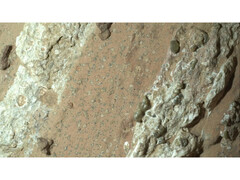Unusual rocks have been discovered on Mars that could potentially provide evidence of past life on the planet. These are a type of 3.5 billion-year-old clay rock found by NASA's Perseverance Rover in a dried-up riverbed in a region called Jezero Crater.
The rocks exhibit unusual patterns reminiscent of leopard spots. Researchers believe these spots may have been formed by chemical reactions related to ancient microbial processes on Mars. Nasa has stated that these could be the clearest signs of life ever found. However, another theory speculates that the causes could be natural geological processes. This would have required higher temperatures, and the stones do not appear to have been intensely heated. Professor Sanjeev Gupta, a planetary scientist at Imperial College London, explains:
We've not had something like this before, so I think that's the big deal. We have found features in the rocks that if you saw them on Earth could be explained by biology - by microbial process. So we're not saying that we found life, but we're saying that it really gives us something to chase.
Although Mars resembles a cold desert today, there is evidence that it had a much denser atmosphere and large amounts of liquid water on its surface billions of years ago. Oceans and rivers made it a warmer and wetter planet. Dr. Nicola Fox, deputy director of NASA's Science Mission Directorate, said of the discovery at a press conference:
It's like seeing a leftover fossil. Maybe it was a leftover meal, maybe that meal's been excreted and that's what we're seeing here.
Whether this is indeed potential evidence of a biosignature or whether it involves non-biological origins – which researchers consider less likely – remains to be seen. Researchers will only get definitive answers when the rocks are examined on Earth.
























